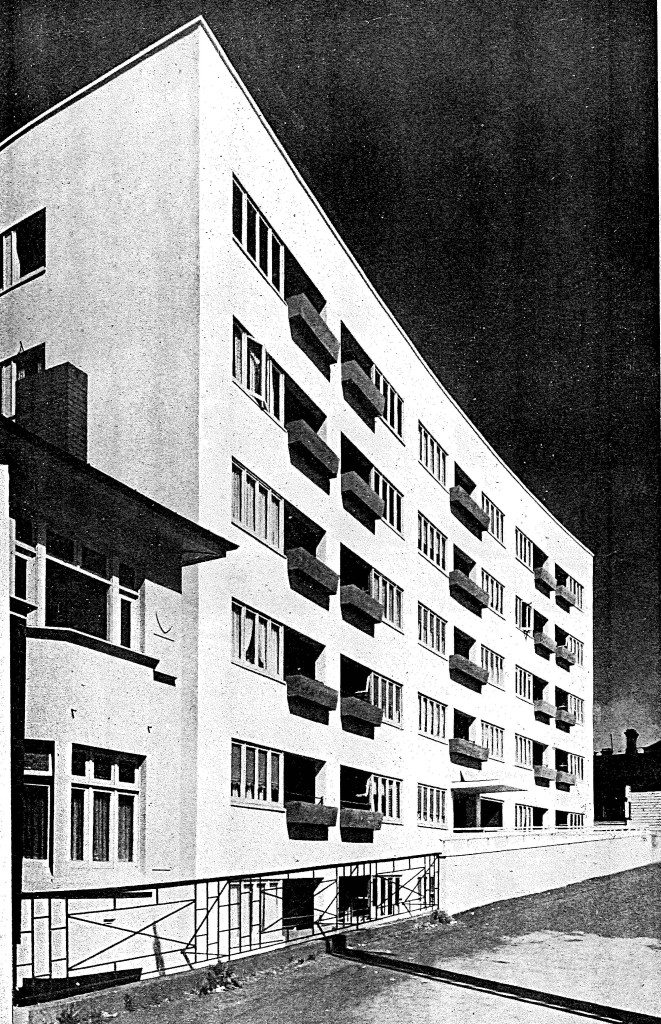I first discovered the elegant curve of the Symonds St Flats in the early 1980s as a student at Auckland University.

I travelled past it every day on my commute to and from my Mount Eden flat, but even as a student of architecture, the building meant nothing much to me at the time … it just looked different, distinctive and from elsewhere … even modern!
At the time modernism, as an architectural and educational ideology, was held in low regard at the Auckland School of Architecture and Post Modernism was all the rage. So other than the occasional lecture from our in-house modernist, Imi Porsolt, I learnt little about architectural modernism other than The Group. It was only after an illuminating two year stint in Melbourne, where I was exposed to the work of Grounds, Romberg, Boyd, McIntyre, Stephenson & Turner, Bates Smart McCutcheon, Harry Seidler, and other significant Australian modernist architects, that I developed an interest in the genre.
On my return in 1986, I landed in Wellington to complete my architecture degree, where, with an enhanced architectural acuity, and as a new member of the Architectural Centre, I discovered our own remarkable body of modernist architecture. As I undertook my under-graduate sub-thesis on New Zealand modernism (“A Liberal Turn of Mind”: The Architectural Work of F. Gordon Wilson 1936-1959 – A Cultural Analysis) I rediscovered the Symonds St Flats and became a fan.
The Symonds St Flats is one of only six medium to high rise multi-unit flats developed in New Zealand by the state, part of the progressive social housing programme initiated by the first Labour Government in 1935 and continued by subsequent mid-century administrations. Along with the Dixon St Flats (1941), McLean Flats (1945), Gordon Wilson Flats (1959) in Wellington, Greys Ave Flats (1947), and Upper Greys Avenue Flats (1957) in Auckland, the Symonds St Flats were designed under the direction and leadership of Gordon Wilson, the Department of Housing Construction’s chief Architect (later to become Government Architect). Émigré Fredrich Neumann (later anglicised to Frederick Newman) worked with Wilson as project architect for the Symonds St Flats … and interestingly the distinctive curved façade subsequently re-surfaced in Neumann’s design of the main entrance to the 1952 Haywards Substation building in the Hutt Valley.

Developed as an alternative to the conventional suburban State Housing model, these multi-unit flats were located in the inner city to “cater for city dwelling couples and senior citizens with no children.” Cedric Firth, in the government’s 1949 PR publication State Housing in New Zealand (1949), noted “It must not be forgotten that there are many people who have interests other than babies and gardens,” freed from the burden of domestic rituals, the flat dweller can, “afford more freedom for the pursuit of their particular interests” that the city offers – visionary thinking given today’s smaller family units and interest in urban development.
Typically these flats were constructed in reinforced concrete and offered one and two bedrooms units arranged around a semi-recessed balcony. This planning module, initiated in the Berhampore Flats and successfully developed in the Dixon St Flats, is cleverly integrated into the Symonds St Flats’ T-shaped footprint with its curved façade greeting the street in an sophisticated and welcoming way, while cleverly disguising the steep slope of its site behind. It’s an architectural gem amongst the visual cacophony of Symonds St.

Largely neglected by its owner Housing New Zealand and at risk of demolition, the Symonds St Flats thankfully have been saved by the recent sale to Auckland University who plan to upgrade it to house post-graduates and their families. Otago University too have recognised the importance of its modernist architectural heritage and is refurbishing and integrating their 1950s dental school into an enlarged new “state of the art” School of Dentistry.
This enlightened approach of both Auckland and Otago University to upgrade and re-use their modernist buildings is to be commended and promoted. Sadly that cannot be said of the current institutional kaitiaki of the Gordon Wilson Flats.
The Symonds St Flats stand out as an urbane and unashamedly modern work of architecture and speak of a time when there was a commitment to providing quality and progressive housing solutions for those in need and which reflected the ideals of the equitable and decent society that Modernism strove to create – something sadly missing today. “Long Live the Modern”!!
Ken Davis, President, Architectural Centre (1991- 1993)
The “My favourite modernist building …” series is in support of Gordon Wilson Flats which is facing threat of demolition.

Leave a Reply